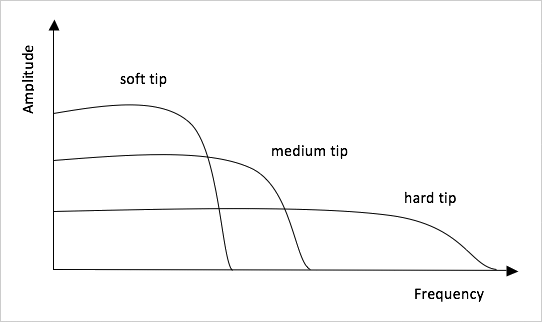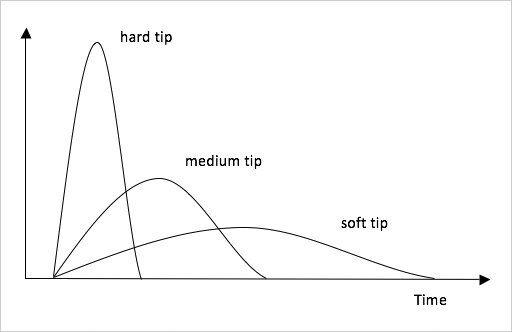Question
I have to carry out a modal test in order to identify the dynamic properties of my test specimen. Is there any rule that could help me in selecting the right modal hammer with respect to e.g. specimen size and mass?
Answer
There is no fixed rule that would provide a clear indication which modal hammer is the most appropriate one to carry out the test. Although there is a set of aspects/factors that has to be considered before the choice of modal hammer is made.
Factor 1. Frequency bandwidth
Modal testing carried out with a modal hammer is based on providing the impact to the specimen, resulting in vibration over a broad frequency bandwidth. The width of frequency band of excited vibration depends on the impact duration. The shorter the pulse width, the higher the frequencies being excited. The impact duration can be changed by mounting special hammer tips of different stiffness. The different hammer tips allow various frequency bandwidths to be excited with the modal hammer, impacting the specimen with the same energy (the softer the hammer tip, the longer pulse, the narrower the excited frequency bandwidth).

The final duration of the pulse, in certain cases, may also depend on the stiffness of the specimen that is being impacted. It is also important to remember that when a hard tip is used, the energy of the impact is being distributed over a wide frequency bandwidth, which means the power spectral density of the excitation may be low in certain cases, too low, to excite specimen vibration modes/resonances. In such cases we may try to hit the structure under test harder by taking a more robust swing or increasing the mass of the hammer by adding a head extender. Unfortunately this approach may also increase the risk of saturating the IEPE force transducer. Therefore, in certain cases, the change to the hammer model featuring a larger measurement range may be considered. Another solution is the application of a softer tip. This results in the energy of the impact being concentrated at lower frequencies (discussed in follow on section).
Factor 2. Amplitude of the pulse
The type of tip being used strongly influences the shape of the impact pulse - not only its duration but also its amplitude. Below graphic shows the force pulses of equal energy applied to the specimen having different hammer tips.

Usage of a hard hammer tip may imply usage of a modal hammer featuring a high measurement range force transducer. The lower measurement range force transducer may limit the usage of the hard hammer tips, which will not allow exciting vibration of high frequencies.
Factor 3. Mass of the hammer, Energy of the impact
The variety of shapes and masses, as well other properties of tested objects, like stiffness or damping require a variety of force pulses of different parameters for proper excitation. In general small compact objects tend to feature higher resonance frequencies and require lower energies of impact to be excited compared to large objects. Therefore in order to excite a small structure most likely at low energy, a short lasting force will be needed. Such a pulse can be provided with small and medium hammers like Endevco 2301 or hammers from Endevco 2302 family. Larger structures will require higher energy impact, most likely concentrated in a low frequency bandwidth. In such cases, larger hammers like Endevco 2303 2304 2305 with soft or medium stiffness tips, will be more appropriate to provide the force pulse excitation desired.
Factor 4. Tests repeatability
To be able to provide the mechanical excitation, of a desired parameter, we need to choose between different force measurement ranges, hammer tips and hammer masses. In practice during modal testing the hammer impacts performed by the operator may differ from one to the other, in terms of impact energy and frequency bandwidth of excited vibrations, as well as the angle of impact. Because of that a common practice is to average several results obtained in particular measurements. The objective is to obtain good quality, repeatable data results obtained in the particular measurements, being as similar as possible.
Modal hammers are available in number of different masses so the hammer operator can provide force pulses of different energies without the necessity of taking big swings during which it is difficult to control the force and angle at which the hammer tip impacts the structure.
The table below contains the list of the Endevco brand modal hammers and their most typical applications:
Endevco Model
|
Meas. Range
lbf (N)
|
Head mass
grams
|
Frequency range (max)
Hz
|
Application
|
2301
|
50 (220)
|
2
|
-
|
Circuit boards, electronics, miniature turbine blades, small machines elements
|
2302-100
|
50 (220)
|
100
|
8000
|
Lightly damped frames, welded elements
|
2302-10
|
500 (2200)
|
100
|
8000
|
Machine parts, automotive elements, electric engines and their elements
|
2302-50
|
100 (445)
|
100
|
8000
|
Automobile frames, engines, electric engines
|
2302-5
|
1000 (4448)
|
100
|
8000
|
Automobile frames, engines, electric engines, larger welded elements
|
2303
|
5000 (22240)
|
454
|
10000
|
Automobile frames (trucks, vans), industrial pumps turbines and their large elements
|
2304
|
5000 (22240)
|
1362
|
10000
|
Machines foundations, tanks, steel constructions
|
2305
|
5000 (22240)
|
5448
|
15000
|
Heavy foundations, ships, buildings, damped constructions (rivet constructions)
|